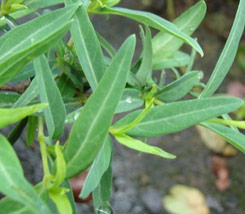Barleria meyeriana
Barleria meyeriana Nees
Family: Acanthaceae
Common names: Meyer's bushviolet (Eng.)
Introduction
Barleria meyeriana is an ideal groundcover to cover areas in full sun in your garden.

Description
Description
Barleria meyeriana is an unarmed (without thorns) straggling herb up to 50 mm high.
Leaves are elliptic-lanceolate, the base tapering into a short petiole (leaf stalk). Young stems are reddish.

One to three flowers are clustered in the leaf axils. The corolla (petals of the flower) is two-lipped. The upper lip is four-lobed and the lower lip entire, lobes deeply divided. Flowers are pale mauve to white with a few dark mauve streaks. Barleria meyeriana flowers from February to May.

The fruit capsules are long-beaked and bear 2 seeds. The ripe fruit capsules explode when they become wet to distribute the seeds in different directions.

Conservation Status
Status
Least Concern (LC).
Distribution and habitat
Distribution description
Barleria meyeriana grows in open woodland, sometimes amongst grasses and shrubs, and has been collected in KwaZulu-Natal, Limpopo and Mpumalanga Provinces and in Swaziland.
Derivation of name and historical aspects
History
Barleria meyeriana is named after E. Meyer, a 19th century German botanist who wrote up a number of Ecklon & Zeyer collections.
Ecology
Ecology
Barleria meyeriana is pollinated by insects and attracts various species of butterflies.
Uses
Use
Barleria meyeriana is quite suitable for landscaping in water-wise gardens, on rockeries and in open sunny patches in your garden.
Growing Barleria meyeriana
Grow
Barleria myeriana is propagated either by seed or cuttings.
To prevent seed loss collect the seed as soon as the seed capsules turn brown. Plant the seed in a mixture of equal parts of river sand and good soil. Place the tray in a shady spot and water well once a week. Ideal soil and air temperature for optimal germination is between 20 and 28°C. Transplant the seedlings in separate pots when they are more or less 100 mm high.
Take softwood cuttings, 120 mm long, dip them in a hormone powder and plant them in a mixture of equal parts of good soil and river sand. The best temperatures for rooting cuttings are between 20 and 30°C. Place the container with cuttings in a cool shady place and water well twice a week. Transplant the rooted cuttings into a good soil mixture (after 3-5 months).
There are no known pests or diseases that attack Barleria meyeriana.
References
- Obermeyer, A.A. 1937. Annals of the Transvaal Museum 15,2: 123-180.
- Germishuizen, G., Meyer, N.L., Steenkamp,Y. & Keith, M. (eds) 2006. A checklist of South African plants. Southern African Botanical Diversity Network Report No. 41. SABONET, Pretoria.
- Pooley, E. 1998. A field guide to wild flowers of KwaZulu-Natal and the Eastern Region. Natal Flora Publications Trust, Durban.
- Plants.jstor.org/Flora/floc 011449
Credits
Willem Froneman
Lowveld National botanical Garden
May 2012
Acknowlegements: Dr. Hugh Glen for the information on the derivation of the species name.
Plant Attributes:
Plant Type: Ground Cover, Perennial, Shrub
SA Distribution: KwaZulu-Natal, Limpopo, Mpumalanga
Soil type: Sandy, Loam
Flowering season: Late Summer, Autumn
PH: Neutral
Flower colour: White, Mauve/Lilac
Aspect: Full Sun
Gardening skill: Easy
Special Features:
Horticultural zones











Rate this article
Article well written and informative
Rate this plant
Is this an interesting plant?
Login to add your Comment
Back to topNot registered yet? Click here to register.